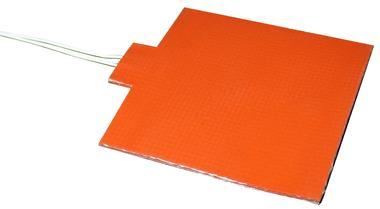THERMAL INSULATION
Although the internal resistive foil may be identical, silicone rubber heaters have certain advantages over polyimide heaters. Silicone rubber provides excellent wear protection from abrasion and mechanical damage if the heater is installed in an area that may be subject to coming in contact with other objects. Silicone rubber also provides a moisture barrier to enable the heaters to be used in outdoor and wet environments. In addition, the top end of the temperature range is higher for SR heaters, providing function up to 232C/455F for continuous use and higher for short duration exposures. Yet the thicker silicone rubber (overall thickness can be .030″ or greater compared to .008″-.010″ for polyimide constructions) introduces a negative aspect. The added thickness and properties of silicone rubber inject a degree of thermal insulation into the thermal transfer from the resistive foil to the mounting surface. This delay of thermal transfer compared to polyimide can have an impact in some applications where extremely fast thermal ramp-up is needed. This thickness also reduces the bending/flexibilty of the heater. With a limited bend radius in the order of 1.5”, this introduces the potential for the heater to not uniformly, securely, and permanently bond to a tightly curved surface. Silicone Rubber also cannot be utilized for space and other applications where out-gassing is restricted.

ADDITIONAL INFORMATION
All Flex offers UL Certified constructions in both Silicone Rubber and Polyimide (U.L. certification maximum temperature is 221F / 105C). Unlike many competitors, All Flex offers silicone rubber heaters with silicone-compatible pressure sensitive adhesive for attaching the heater onto its mounting surface. This option permits customers to bond the heater instead of forcing the heater manufacturer to pre-mount the heater using vulcanizing lamination processes.
HEAT TRANSFER
Adhesion of the heater to its mounting surface is a critical factor in the performance of the heater to ensure that thermal energy transfers out of the heating element. Customers are to ensure a uniform and proper interface between the heater and the mount location.
